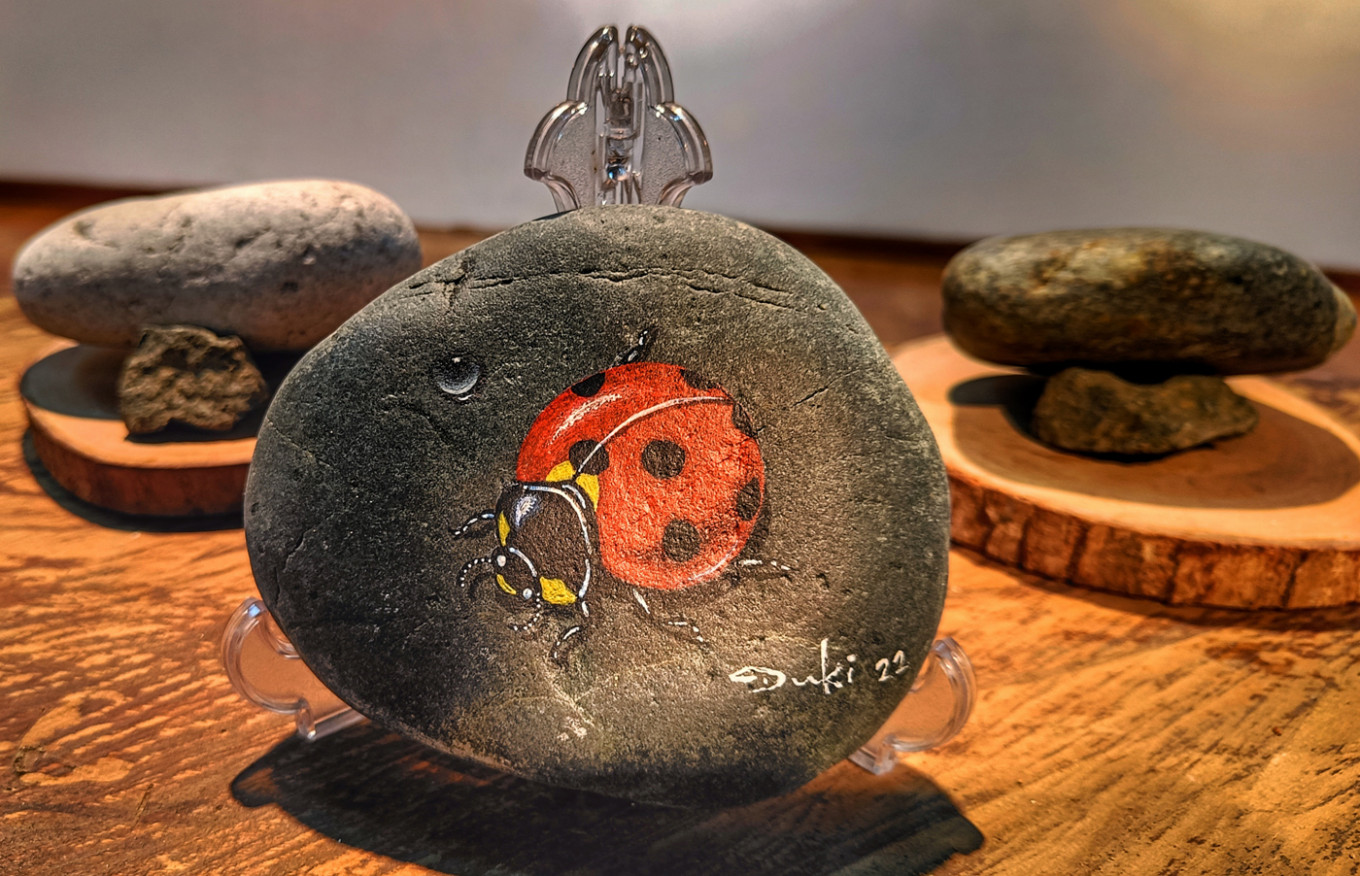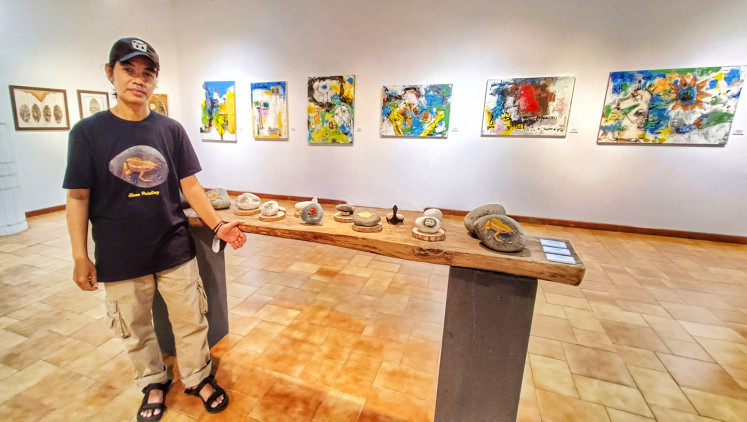Popular Reads
Top Results
Can't find what you're looking for?
View all search resultsPopular Reads
Top Results
Can't find what you're looking for?
View all search resultsDuki Noermala: The painter turning stones into art
Change text size
Gift Premium Articles
to Anyone
Artist Duki Noermala channels his talent in painting on natural material: Stones.
Stones exist everywhere around us. We find them in the streets, in the parks and by the river — rarely thinking much of them. But in the hands of an expert, each stone could turn into a valuable work of art.
Stone paintings by Bogor artist Duki Noermala are one such example. Many of them, portraying highly detailed three-dimensional plants or animals, are valued at millions of rupiah.
From May 14 to 22, Bentara Budaya Jakarta showcased artwork by artists from Bogor in an exhibition, titled Nujudibumi (In Sundanese, literally Being at Home). On May 14, Duki Noermala also hosted a stone-painting workshop for the public.
Duki has not always worked on stones. The artist was already proficient in painting using acrylic and watercolor on canvas. But after painting daily for many years, the father of two experienced artists’ block in 2019.
“Suddenly, I felt bored and couldn’t work for weeks,” he said.
To unwind, Duki one day headed to a creek near his house. That afternoon, as he was standing by the bridge watching fishermen at work and young boys playing in the stream, his eye was caught by the shiny, smooth pebbles on the riverside.
“They seem to be beckoning me to work on them,” he said.
He then took some of the stones home and tried painting on them.
“I used up more than a dozen brushes trying to paint on the stones’ rough surface,” he said.
The first object that this realist artist painted on stone was an animal that he often saw in his own backyard, a toad. A collector, who came to his workshop on the next day, saw the finished product and made a purchase.
“I took it as a sign to keep working on stones,” the artist said.
Today, among Duki’s loyal customers include Bogor Mayor Bima Arya Sugiarto and real estate magnate Ciputra.
Live painting: Duki Noermala paints a stone during a workshop at Bentara Budaya Jakarta. (JP/Sylviana Hamdani) (JP/Sylviana Hamdani)Persistence
Duki has always loved to draw. Even as a child, when boys his age played soccer, he preferred sitting down under a tree with his sketchbook.
As Duki walked home from school, he often passed by the house of Bogor’s realist artist Sukirno. In his living room were seated aspiring painters of various ages learning to paint from their senior.
Sukirno was among Indonesia’s Mooi Indie maestros. Today, his work still embellishes the ceramic walls of Teater Imax Keong Mas in Taman Mini Indonesia Indah in East Jakarta.
One day, the then 70-year-old painter noticed Duki peeking in from the gate and invited him to join his painting class.
“I was beyond ecstatic,” he said, with a laugh. “Pak Sukirno gave me a piece of paper and a pencil and taught me to sketch.”
The young boy kept coming back. Right after school, he rushed home for lunch and a quick shower and then headed to Sukirno’s house for his art lesson.
“For one whole year, he wouldn’t teach me anything but sketching,” he said. “He wanted me to be fully established in the basics of painting.”
As Duki proved himself to be diligent and persistent, Sukirno started to trust the juvenile more. The maestro then imparted his prized watercolor techniques to the 14-year-old boy.
When the senior painter became ill toward the end of his life, he introduced his protégé to some of his clients.
“Then and there, I decided to follow in his footsteps and became a painter,” Duki said.
To hone his skills, Duki also joined several art communities, including Bogor Sketchers and Kolcai (Indonesia Watercolor Artists).
A pinnacle in Duki’s career was his solo exhibition at the official residence of the tourism minister in Jakarta in 1997.
“Thirty-five of my watercolor paintings were sold out on the opening day,” he said, with a proud smile.
The 52-year-old is now planning for a solo exhibition for his stone paintings.
His creations: Duki Noermala showcases his stone paintings during a solo exhibition at Bentara Budaya Jakarta (JP/Sylviana Hamdani) (JP/Sylviana Hamdani)‘There’s an artist in every one of us’
During the stone-painting workshop run by Duki in Bentara Budaya Jakarta that afternoon, Ali Murtado seemed to be lost in his own world. His little hands eagerly tossed and turned a pile of rocks scattered on the floor. The six-year-old then chose two small pebbles and started painting on them.
On one stone, the boy drew a man with curly red hair, on another a bumblebee.
“There’s an artist in all of us,” Duki said, watching the small boy. “We all can create something beautiful if we set our heart to it.”
Duki has shared some useful tips for those also wanting to paint on stones.
For a starter, they should find nonporous rocks that are flat and have a smooth surface. These can usually be found by the river or in parks.
“You can also buy them in gardening shops, if you want to,” Duki said.
These stones should be washed using a toothbrush to get rid of any dirt that might be stuck on them. Then, dry them thoroughly.
Sketching on the stone can be done by using a white crayon or pencil.
“Feel free to explore your creativity,” Duki said. “You can draw objects that you see or anything that comes to mind.”
After the sketching process, the stones can then be painted using acrylic.
According to Duki, acrylic paint is the best material to use when painting on stones. It covers the surface evenly and dries quickly.
Acrylic brushes should also be used using synthetic bristles, instead of natural ones, as these brushes are usually more resistant to wear and tear, especially when used on the stone’s rough surface.
To finish, the painting should be sprayed with varnish.
“Personally, I prefer using matte [instead of glossy] varnish on my works, as it doesn’t affect the colors,” Duki said.
Another participant in the afternoon’s workshop was Maya Agustina, a high-school art teacher from Bogor who drew chilies, onions, garlic, shrimp paste and a pinch of salt on a palm-size black stone.
“These are the ingredients that we use for making sambal [freshly ground chili sauce],” she said, with a laugh.
It was the first time for the art teacher to paint on stones.
“I find it very relaxing,” Maya said.
“Art is indeed therapeutic,” Duki said. “Moreover, painting on stones is quite cheap as the main material [stone] is readily available in nature.”













